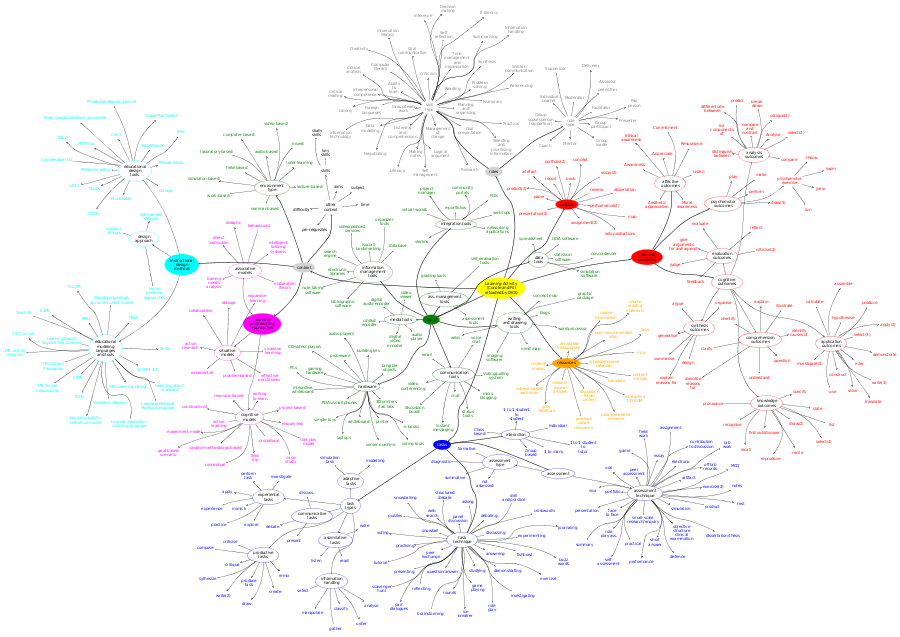Teaching and learning taxonomy
 From EduTechWiki - Reading time: 3 min
From EduTechWiki - Reading time: 3 min
This article shortly summarized various taxonomies that describe teaching strategies and tactics (e.g. instructional designs or elements of the learning environment) plus "ingredients" of learning (e.g. learning types, levels, etc.)
Learning types and levels[edit | edit source]
Broad learning types (or learning domains) include attitudes, facts, concepts, reasoning, procedures, problem solving, learning strategies, attitudes and motor skills.
Some authors group these in various ways. E.g. Gagné (1975 ?) distinguishes between verbal information, intellectural skills (discrimination, concrete concepts, define concepts, rules, higher-order rules), cognitive strategy, attitudes and motor skills.
Carson (2004), with respect to curriculum planning distinguishes: Empirical knowledge, Rational Knowledge, Conventional Knowledge, Conceptual Knowledge, Cognitive Process Skills, Psychomotor Knowledge, Affective Knowledge, Narrative Knowledge and Received Knowledge.
Often, learning domains are presented in some form of hierarchy that represent a learning level. E.g. Bruner, based on Piaget, identified enactive, iconic and symbolic stages. Bloom with respect to the cognitive domain, identified six levels of intellectual behavior (knowledge, comprehension, application, analysis, synthesis, evaluation). Gagné (1965) arranged learning types into signal learning, simulus-response learning, chaining, verbal association, discrimation learning, concept learning, principle learning and problem solving.
More recent authors from the field of education, defined learning in terms of stages in the curriculum, e.g. Mayes and Fowler (1999) identify a simple three-stage model: conceptualization, construction and application. In a similar way, Merril distinguishes between information only, information-only plus demonstration, information plus demonstration plus application and finally task-centered with demonstration and application. Similarly Taba proposed a three stage model leading through concept formation, interpretation of data and application of principles.
Krathwohl (2002), based on his original work with Bloom identifies: Recall, Explain, Apply, Analyse, Evaluate and Create.
Teaching strategies[edit | edit source]
Teaching strategies or teaching approaches either refer to loosely defined pedagogic methods, teaching styles etc. or to more precisely formulated instructional design models (not methods, i.e. models in the sense of instructional systems design).
Often, pedagogic strategies are discussed and defined with respect to general learning theoretical concepts, e.g. Behaviorism, Cognitivism, Constructionism, Constructivism, Socio-constructivism, Situated learning, etc. However, it should be clear that a learning theorectical stance doesn't imply a given pedagogical model of the same kind. E.g. one may strongly believe that knowledge must be constructed (psychology) but can adopt an instructional/cognitivist teaching approach.
Joyce, Weil and Calhoun (2000) defined 4 major families of models for teaching, i.e. strategies that are used in schooling. Behavioral systems family of models, Information-processing family of models, Personal family of models, and Social family of models.
Learning designs[edit | edit source]
Learning designs may include references to broad educational scenarios (pedagogical approaches) and sequencing elements.
A well know taxonomy was defined by Reeves (and Reeves)
Instructional architecturs[edit | edit source]
The following table somewhat integrates types and levels and is based on work by Baumgartner and Kalz
|
Learning categories - suitable for instructional design planning |
|
|---|---|
|
I: know that |
I-a Facts : recall, description, identification, etc. |
|
I-b Concepts: discrimination, categorization, discussion, etc. |
|
|
II: know how |
II-a Reasoning and procedures: inferences, deductions, etc. + procedure application |
|
II-b Problem solving and production strategies: identification of subgoals + application of heuristics/methods |
|
|
III: knowing in action |
III Situated action: action strategies in complex and authentic situations |
|
IV: Other |
IV Other: e.g. motivation, emotion, reflection, i.e. elements that could intervene in all the other categories |
Ruth Clark (1998) suggests four different instructional architectures (receptive, directive, guided discovery, and exploratory)
Monster models[edit | edit source]
The Reeves and Reeves model of CBT/L and Joyce, Weil and Calhoun models of teaching are often considered complex, there is more.
In the now frozen DialogPlus Toolkit project, Conole and Fill attempted to defined teaching and learning as a multiple hiearchy of components in a similar way chemistry and micro-biology looks at objects.

Conole and Fill learning taxonomy shows our attemps to visualize such models on a single Poster. You need an SVG capable browser (Firefox, Opera, Chrome, Safari) to be able to look at the full picture.
Links[edit | edit source]
- Contextual map of the ARV 2011 white papers (Stellar Alpine Rendez-Vous 2011)
Bibliography[edit | edit source]
- Gagne, Robert M. (1975). Essentials of Learning for Instruction. New York: Holt, Rinehart and Winston.
- Bloom Benjamin S. and David R. Krathwohl. Taxonomy of Educational Objectives: The Classification of Educational Goals, by a committee of college and university examiners. Handbook I: Cognitive Domain. New York, Longmans, Green, 1956.
- Baumgartner, P. (2004). The Zen Art of Teaching - Communication and Interactions in eEducation. Proceedings of the International Workshop ICL2004, Villach / Austria 29 September-1 October 2004, Villach, Kassel University Press. CD-ROM, ISBN: 3-89958-089-3. PDF
- Baumgartner, P. & Kalz, M. (2004). Content Management Systeme aus bildungstechnologischer Sicht in Baumgartner, Peter; Häfele, Hartmut & Maier-Häfele, Kornelia: Content Management Systeme für e-Education. Auswahl, Potenziale und Einsatzmöglichkeiten, Studienverlag, Innsbruck 2004.
- Krathwohl, D. R. (2002). “A revision of Bloom’s taxonomy: An overview.” Theory into Practice 41(Autumn): 212–218.
 KSF
KSF